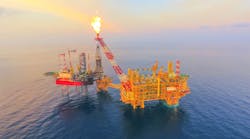Editor's note: This story first appeared in the March-April 2023 issue of Offshore magazine's Energy Transformation Strategies Special Report.
By Julien Perez, Oil & Gas Climate Initiative
Action on methane must happen, and quickly.
As spoken by US Special Presidential Envoy for Climate John Kerry at the closing of COP27, “Tackling methane is the fastest, most effective way to reduce near-term warming and keep 1.5℃ within reach." This was a clarion call to the oil and gas industry.
Methane is responsible for more than a quarter of global warming and is more than 80 times more powerful than CO2 in the atmosphere over a 20-year timeframe. It is also short-lived. While CO2 lingers in the atmosphere for hundreds of years, methane dissipates quickly, with a half-life of approximately a decade.
The nature of methane means it is highly potent but, crucially, the impact can be huge if mitigated. The Global Methane Pledge, signed by 150 countries, calls for a 30% cut in methane emissions from all sectors by 2030.
Methane emissions come from multiple sources, with the oil and gas industry estimated to contribute about 20% of the total. Those emissions contribute 50% of the oil and gas industry’s direct emissions, amounting to 2 Gt CO2e per year or 5% of global greenhouse-gas (GHG) emissions. According to the IEA, eliminating those emissions by 2030 would be equivalent to neutralizing two-thirds of the global transport sector’s GHG emissions.
Studies are available that help people understand methane emissions from the offshore industry. Research led by Carbon Mapper, a non-profit, flew over 8% of the shallow-water facilities in the US Gulf of Mexico (GoM), concluding that methane emissions from those assets was substantially higher than those from onshore assets—23% to 66% from the offshore platforms compared with 3.3% to 3.7% in previous studies of drilling activity in the Permian Basin in Texas and New Mexico.
Oil & Gas Climate Initiative (OGCI) also funded a scientific study measuring 103 deepwater and shallow offshore platforms and drillships in the GoM, with methane emission rates ranging from 0 to 190 kg/h and with the top two emitters accounting for 20% of the total methane emissions of all sampled sites. Despite the greater throughput of the deepwater facilities, they had moderate emission rates compared to shallow-water sites.
The breadth of results and performance across facilities highlights the challenge of rapid mitigation and more accurate quantification and reporting of methane emissions.
Quantifying methane emissions offshore with technology
Methane leaks are difficult to detect offshore as emissions usually originate from leaks and incomplete combustion from flaring alone, where equipment is not designed to vent since this is dangerous for the crew. However, it is not an impossible task. Cost-effective, reliable technology does exist for the offshore sector.
In May 2022 TotalEnergies, an OGCI member company, launched a worldwide drone-based emissions detection and quantification campaign across all its onshore and offshore operated sites. The campaign, using Airborne Ultra-Light Spectrometer for Environmental Application technology, has shown the success of a miniature dual sensor mounted on a drone to detect methane and CO2 emissions, while at the same time identifying their source. The campaign detected emissions below 10kg/hour.
OGCI Climate Investment’s portfolio company, Seekops, has worked with bp to enhance offshore methane measurement by using a simulation tool for analysis and flight planning, an air pollutant plume dispersion equation and relative standard deviation to map expected concentration fluctuations from sites on the North Sea.
Innovative approaches are also being tested to leverage satellite monitoring on water, which is a technology that previously couldn’t work at sea. In August 2022, GHGSat detected the smallest offshore methane emission ever seen from space, off the coast of Louisiana, and it measured at approximately 1,500 kg/hr, linking it to a fugitive methane emission from an offshore oil and gas platform.
Continuous monitoring could potentially play a big role offshore through installing fixed sensors around the platform to continuously detect, quantify and locate the methane emissions. However, progress needs to be made on the quantification and localization.
Collaboration
Even with available and cost-effective technology, tackling methane offshore isn’t going to happen without collective endeavor and commitment. The industry needs a step change in attitude toward methane leaks so they are treated as seriously as the industry already treats accidents—aiming for zero.
This mission statement led to OGCI’s launch of the Aiming for Zero Methane Initiative. The initiative calls on all members of the industry to sign up to the principle of striving to reach near-zero methane emissions from operated oil and gas assets by 2030 and implement all responsible means to avoid methane venting and flaring and repair detected leaks. All organizations working in the offshore sector are encouraged to join companies, such as Petrobras, Saipem, SLB and Baker Hughes, to become signatories or supporters of the initiative.
About the author:
Julien Perez is OGCI's vice president of strategy and policy. References for this article are available upon request.









